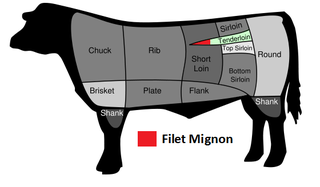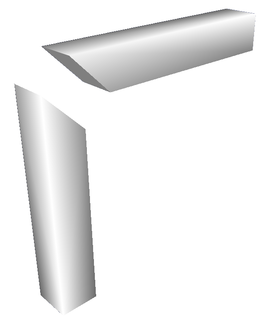
Katsuobushi is dried, fermented, and smoked skipjack tuna. It is also known as bonito flakes when young bonito is used as an inexpensive substitute for skipjack tuna. Katsuobushi or similarly prepared fish, is also known as okaka (おかか).

A butcher is a person who may slaughter animals, dress their flesh, sell their meat, or participate within any combination of these three tasks. They may prepare standard cuts of meat and poultry for sale in retail or wholesale food establishments. A butcher may be employed by supermarkets, grocery stores, butcher shops and fish markets, slaughter houses, or may be self-employed.

Deba bōchō are Japanese style kitchen knives primarily used to cut fish, though also used when cutting meat. They come in different sizes, sometimes up to 30 cm (12 inches) in length. The deba bōchō first appeared during the Edo period in Sakai. It is designed to behead and fillet fish. Its thickness, and often a more obtuse angle on the back of the heel allow it to cut off the heads of fish without damage. The rest of the blade is then used to ride against the fish bones, separating the fillet. Traditionally, these are made of carbon steel, which needs regular maintenance and oiling to prevent rust. However, many modern knives are also available in stainless steel. The carbon steel blades can be honed into a sharper cutting edge.

Butterflying is a way of preparing meat, fish, or poultry for cooking by cutting it almost in two, but leaving the two parts connected; it is then often boned and flattened. Spatchcocking is a specific method for butterflying poultry that involves removing the backbone, and spatchcock as a noun may refer to a bird prepared in that way.

Filet mignon is a steak cut of beef taken from the smaller end of the tenderloin, or psoas major of the cow carcass, usually a steer or heifer. In French, this cut is always called filet de bœuf, as filet mignon refers to pork tenderloin.

Moulding, also known as coving(United Kingdom, Australia), is a strip of material with various profiles used to cover transitions between surfaces or for decoration. It is traditionally made from solid milled wood or plaster, but may be of plastic or reformed wood. In classical architecture and sculpture, the molding is often carved in marble or other stones.
Scrod or schrod is a small cod or haddock, and sometimes other whitefish, used as food. It is usually served as a fillet, though formerly it was often split instead.

A chamfer or is a transitional edge between two faces of an object. Sometimes defined as a form of bevel, it is often created at a 45° angle between two adjoining right-angled faces.

A coping saw is a type of bow saw used to cut intricate external shapes and interior cut-outs in woodworking or carpentry. It is widely used to cut moldings to create coped rather than mitre joints. It is occasionally used to create fretwork though it is not able to match a fretsaw in intricacy of cut, particularly in thin materials. Coping saw blades are always thicker and much coarser cutting than typical fretsaw blades and many others of its family members. Coping saws can however cut slight bends in the work, allowing circles to be cut if used carefully.

The strip steak is a cut of beef steaks from the short loin from a cow. It consists of a muscle that does little work, the longissimus, making the meat particularly tender, although not as tender as the nearby psoas major or tenderloin. Unlike the tenderloin, the longissimus is a sizable muscle, allowing it to be cut into larger portions.

A mitre joint is a joint made by cutting each of two parts to be joined, across the main surface, usually at a 45° angle, to form a corner, usually a 90° angle. It is called beveling when the angled cut is done on the side, although the resulting joint is still a mitre joint.

A fillet or filet is a boneless cut or slice of meat or fish. The fillet is often a prime ingredient in many cuisines, and many dishes call for a specific type of fillet as one of the ingredients.

The fretsaw is a bow saw used for intricate cutting work which often incorporates tight curves. Although the coping saw is often used for similar work, the fretsaw is capable of much tighter radii and more delicate work. It has a distinctive appearance due to the depth of its frame, which together with the relatively short five inch blade makes this tool appear somewhat out of proportion compared with most other saws.

A rib steak is a beef steak sliced from the rib primal of a beef animal, with rib bone attached. In the United States, the term rib eye steak is used for a rib steak with the bone removed; however, in some areas, and outside the U.S., the terms are often used interchangeably. The "rib eye" or "ribeye" was originally, the central portion of the rib steak, without the bone, resembling an eye.

The pork tenderloin, also called pork fillet or Gentleman's Cut, is a long thin cut of pork.

In the picture framing industry, a mat is a thin, flat piece of paper-based material included within a picture frame, which serves as additional decoration and to perform several other, more practical functions, such as separating the art from the glass. Putting mats in a frame is called matting, a term which can also usually be used interchangeably with mat. The French term, occasionally used in English, is passe-partout. A picture is placed beneath it, with the cutout framing it. The passe-partout serves two purposes: first, to prevent the image from touching the glass, and second, to frame the image and enhance its visual appeal. The cutout in the passe-partout is usually beveled to avoid casting shadows on the picture. The French word may also be used for the tape used to stick the back of the picture to its frame.

In the picture framing industry, a fillet is a small piece of moulding which fits inside a larger frame or, typically, underneath or in between matting, used for decorative purposes. The picture framing term is probably related to, though not necessarily derived from, the engineering term, which it is frequently pronounced similarly to; however, unlike the use of fillets in mechanical engineering, the use of "fillets" in picture frames is wholly decorative.

A fish fillet, from the French word filet meaning a thread or strip, is the flesh of a fish which has been cut or sliced away from the bone by cutting lengthwise along one side of the fish parallel to the backbone. In preparation for filleting, any scales on the fish should be removed. The contents of the stomach also need careful detaching from the fillet. Because fish fillets do not contain the larger bones running along the vertebrae, they are often said to be "boneless". However, some species, such as the common carp, have smaller intramuscular bones called pins within the fillet. The skin present on one side may or may not be stripped from the fillet. Butterfly fillets can be produced by cutting the fillets on each side in such a way that they are held together by the flesh and skin of the belly.

The bocadillo or bocata, in Spain, is a sandwich made with Spanish bread, usually a baguette or similar type of bread, cut lengthwise. Traditionally seen as a humble food, its low cost has allowed it to evolve over time into an iconic piece of cuisine. In Spain, they are often eaten in cafes and tapas bars.

















